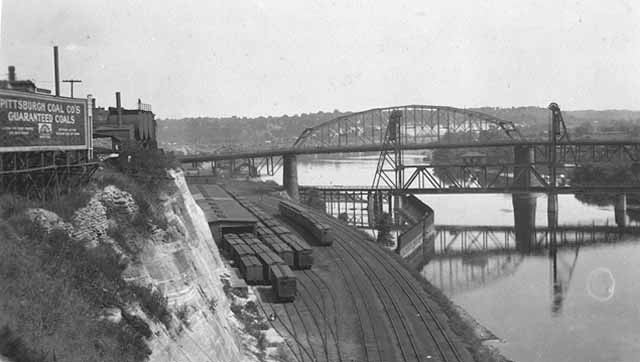A View of the Lower Landing
Introduction
Text-to-speech Audio
Images
Lower Landing Park

Lower Landing (1865)

Lower Landing with (lost) Union Depot (1900)
union%20depot.jpg)
Railroad tracks near Lower Landing (1922)

Backstory and Context
Text-to-speech Audio
This landing, called the Lower Landing, was located just past the Robert Street Bridge and ran along river’s edge for the length of 4-5 city blocks where the waters that drained from this plateau joined a large creek that flowed from north St. Paul down to the Mississippi.
Our capitol city might have remained a relatively minor fur trade post if it hadn't been for this landing, along with a second located just under a mile southeast of here near the Science Museum of Minnesota. These landings made St. Paul the head of navigation on the Mississippi River when it was the busiest transportation route in North America.
- The first steamboat arrived here in 1850 just as the international fur trade that had fueled the local economy was beginning to collapse.
- Between 1850 and 1863, US and Minnsota officials violently expelled thousands of Dakota and Ho Chunk people from the state and forced the removal of Ojibwe people to northern reservations altering St. Paul's earlier multiracial reality.
- At the same time, the people who had negotiated the treaties and expelled and removed Native Minnesotans from this land created a new economy based on land speculation and colonization that, aided by booming steamboat traffic, raised St. Paul's population by 900% in ten years.
From about 1850 until the late 1880s when the railroads were established, the Lower Landing was one of the busiest steamboat landings in the United States and the primary point of entry for people, goods and information in St. Paul. This is where:
- Hundreds of American and Europea colonists arrived each day during the land speculation boom of the 1850s.
- Where enslaved African Americans escaping through the Underground Railroad landed in search of the Underground Railroad stop operated by Black barber William Taylor and his wife Adeline on Kellogg Boulevard.
- Where a group of self-emancipated African Americans arrived by raft in 1863 to make St. Paul their new home and to found the state's oldest Black church, Pilgrim Baptist.
- Where VIP’s, well-wishers, and bands greeted Minnesota soldiers returning from combat against the Confederacy during the Civil War.
Despite the railroads having long overtaken riverboats as the primary mode of distance transportation in St. Paul, the federal Works Progress Administration renovated the landing during the Great Depression as part of a riverfront revival project.
Most of the landing was removed in the 1950s for the construction of Warner Road, but tows and passenger steamboats still use what remains today and Lower Landing Park stands as a reminder of what was lost and gained as Saint Paul became an American city.
Cite This Entry
Dart, Danielle and Clio Admin. "A View of the Lower Landing." Clio: Your Guide to History. August 14, 2020. Accessed April 26, 2025. https://theclio.com/tour/1463/5/reverse
Sources
Lambert's Landing, Mississippi National River and Recreation Area. February 28th 2020. Accessed July 22nd 2020. https://www.nps.gov/miss/planyourvisit/lambland.htm.
Millett, Larry. Lost Twin Cities. Saint Paul, MN. Minnesota Historical Society Press, 1992.
Swanson, Deborah. Joseph Farr remembers the Underground Railroad in St. Paul . Minnesota History Magazine. October 1st 2020. 123 - 129.
Trenerry, Walter. When the Boys Came Home. Minnesota History Magazine. June 1st 1963. 287 - 297.
Visit Saint Paul
Minnesota Historical Society
Minnesota Historical Society
Minnesota Historical Society

